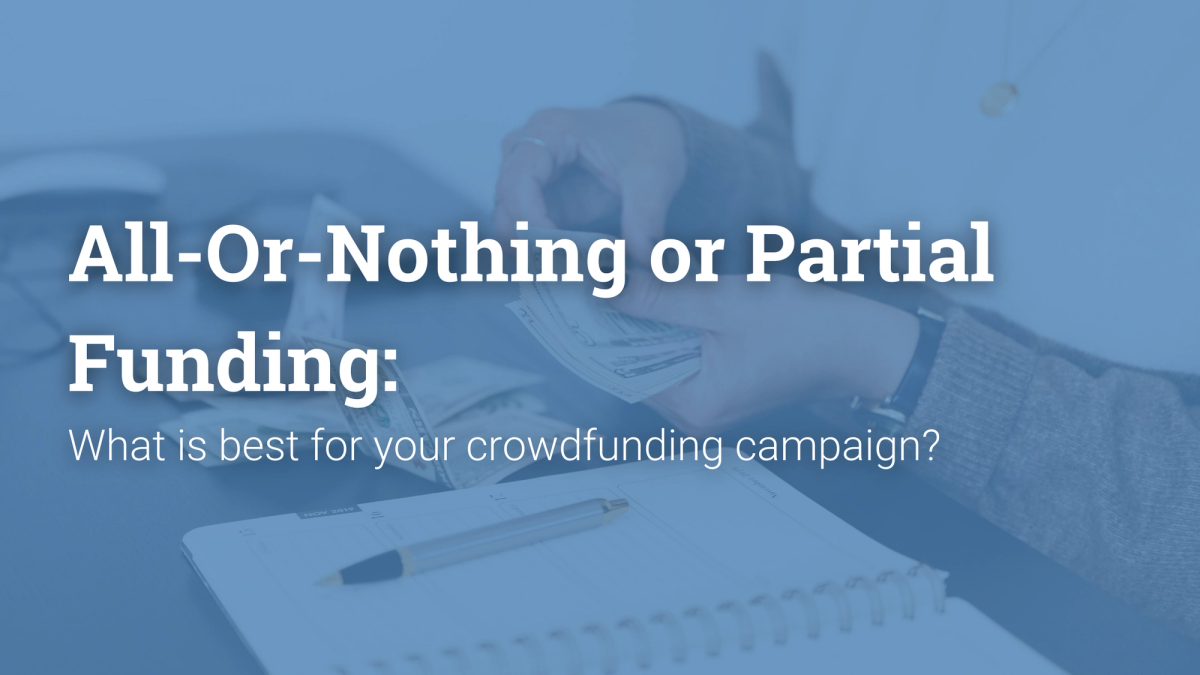
All-Or-Nothing or Partial Funding: What is best for your crowdfunding campaign?
We’ll take you through the benefits of the two funding models - All-Or-Nothing and Partial Funding - to help you decide which is best for your campaign.
Most crowdfunding platforms, including Patronicity, offer two standard crowdfunding models for individuals and organizations to use to raise funds: partial funding or all-or-nothing funding. But what model is best for your campaign?
In this blog, we’ll take you through the definitions and benefits of the two funding models to help you decide what is best for your campaign. We’ll also cover the impact crowdgranting (our unique model combining crowdfunding with a matching grant) has on your funding model selection.
Partial Funding Defined
Partial funding, sometimes referred to as Keep-It-All, is a funding model for crowdfunding that collects the funds it raises as they come in, regardless of whether or not it reaches its goal.
All-Or-Nothing Funding Defined
All-or-nothing funding only collects online funds if the campaign goal is reached by the deadline. Cards are not charged until the goal is reached, so if the campaign ends before reaching the goal, cards are never charged.
The Benefits of Partial Funding
Partial funding campaigns are more commonly seen on Patronicity’s crowdfunding platform.
This is because we work with crafty project creators who can do a lot with whatever amount they raise! They want to keep the fruits of their labor, even if it’s not the full amount of their original goal.
Partial funding allows for flexibility while generating momentum and energy behind the project.
With our community-driven approach, even if campaigns only receive partial funding, the community reaps the rewards and sees the impact a partial project can have on their neighborhood. The Patronicity crowdfunding platform makes it easy to update donors on campaign progress and allows for transparency with patrons in case things change.
This is our recommended model for most campaigns.
The Benefits of All-Or-Nothing Funding
All-or-nothing campaigns have the power to create a sense of urgency for patrons to give. Patrons know that if the project does not hit it’s crowdfunding goal, the project won’t happen at all. Thus, some patrons are encouraged to pledge at higher amounts, knowing their contributions will support a guaranteed project.
Teams that choose all-or-nothing may have confidence in reaching their goal and appreciate the extra motivation all-or-nothing inspires — “we got this!”
Teams that choose all-or-nothing may also take an “it’s now or never” approach if the project cannot be completed with a partial budget and there is no time to continue fundraising after the crowdfunding campaign. All-or-nothing is best for campaigns that must reach a certain goal amount to make any part of the proposed project happen. This can be good for projects that are planning to purchase expensive items like a large piece of playground equipment, a film projector, or a vehicle, cases that we’ve seen in our placemaking and small business crowdfunding campaigns.
Kickstarter “established the all-or-nothing model when (they) launched in 2009 as a measure to protect creators and to minimize risk for everyone. Not releasing funds unless a project meets its goal ensures that creators have enough money to do what they promised, and they’re not expected to complete a project without the funds necessary to do so. This also assures backers that they’re only funding creative ideas that are set to succeed.”
Fundera found that campaigns that used the all-or-nothing model funded fully at twice the rate of keep-it-all campaigns. “A study compared the success of all-or-nothing versus keep-it-all campaigns. Because of the lessened perceived risk of all-or-nothing campaigns, 34% of them fully funded successfully, whereas only 17% of keep-it-all campaigns reached their goal. Knowing that they might not be charged for their donation if a campaign doesn’t reach its goal seems to make potential donors more willing to back a campaign.”
Crowdgranting and its Impact on Funding Models
Crowdgranting is our unique model that combines crowdfunding with a matching grant from one of our partners. If an approved crowdfunding project reaches its goal, the project will receive a matching grant to further the project’s impact on the community. Successful crowdgranting projects leverage support from their community to receive grant dollars and the community acts as the final review committee.
Because of our unique crowdgranting model, we see that partial funding crowdgranting campaigns typically have the same sense of urgency, if not more, than an all-or-nothing campaign. Communities jump into action because they see the large amount of matching funds that are on the line if the campaign does not reach its goal.
As you can see, selecting a funding model can come down to your specific project goals. Our team of expert Project Coaches can help you decide the model that works best for you and your campaign.

